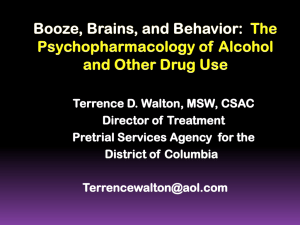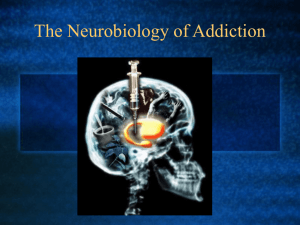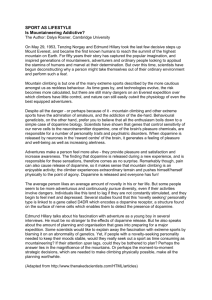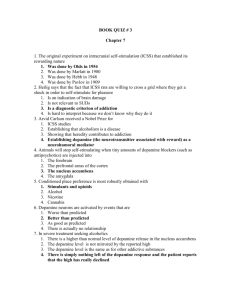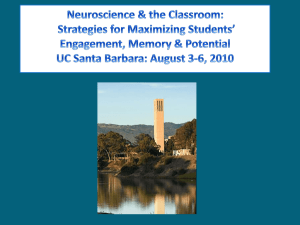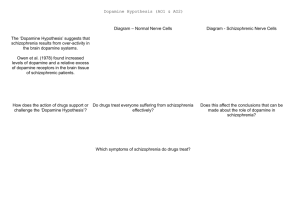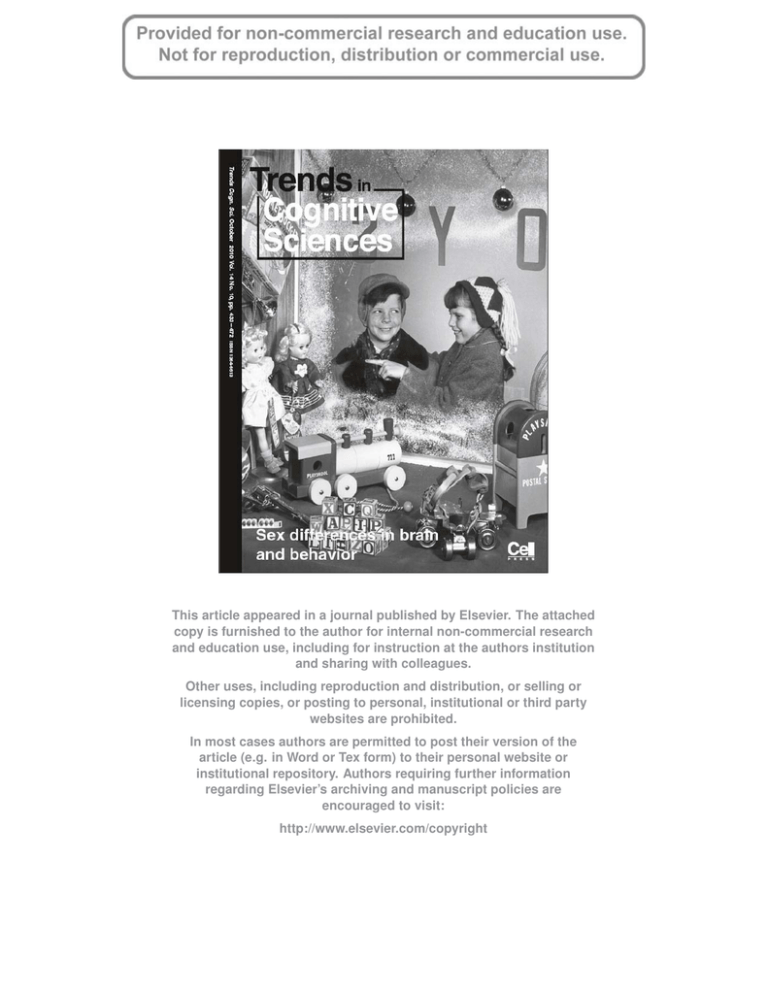
This article appeared in a journal published by Elsevier. The attached
copy is furnished to the author for internal non-commercial research
and education use, including for instruction at the authors institution
and sharing with colleagues.
Other uses, including reproduction and distribution, or selling or
licensing copies, or posting to personal, institutional or third party
websites are prohibited.
In most cases authors are permitted to post their version of the
article (e.g. in Word or Tex form) to their personal website or
institutional repository. Authors requiring further information
regarding Elsevier’s archiving and manuscript policies are
encouraged to visit:
http://www.elsevier.com/copyright
Author's personal copy
Review
Dopamine and adaptive memory
Daphna Shohamy1* and R. Alison Adcock2*
1
2
Department of Psychology, Columbia University, New York, NY 10025, USA
Center for Cognitive Neuroscience, B253 Levine Science Research Center, Duke University, Box 90999, Durham, NC 27708, USA
Memory is essential to adaptive behavior because it
allows past experience to guide choices. Emerging findings indicate that the neurotransmitter dopamine, which
signals motivationally important events, also modulates
the hippocampus, a crucial brain system for long-term
memory. Here we review recent evidence that highlights
multiple mechanisms whereby dopamine biases memory towards events that are of motivational significance.
These effects take place over a variety of timescales,
permitting both expectations and outcomes to influence
memory. Thus, dopamine ensures that memories are
relevant and accessible for future adaptive behavior, a
concept we refer to as ‘adaptive memory’. Understanding adaptive memory at biological and psychological
levels helps to resolve a fundamental challenge in memory research: explaining what is remembered, and why.
Introduction
Memory is essential to behavior, enabling organisms to
draw on past experience to improve choices and actions.
Much research has focused on how the hippocampus builds
accurate memory for past events. Emerging findings indicate that the neurotransmitter dopamine, known to play a
key role in motivated behavior, has a direct impact on
memory formation in the hippocampus. Here, we review
this emerging literature that demonstrates that interactions between midbrain dopamine regions and the hippocampus promote memory for episodes that are rewarding
and novel and build memory representations well-suited to
guide later choices. By integrating findings from both human and animal research, we argue for a framework in
which dopamine helps create enriched mnemonic representations of the environment to support adaptive behavior.
The hippocampus: Creating building blocks for
memory-guided behavior
After decades of research, our understanding of the brain
mechanisms that contribute to long-term memory for
events or episodes – often referred to as episodic memory
– has evolved significantly. Episodic memories are formed
rapidly (after even a single experience) and are rich in
contextual details. Episodic memories are also thought to
be relational: they encode relationships between multiple
elements of an event [1,2]. Extensive converging evidence
indicates that episodic memory depends crucially on the
hippocampus and surrounding medial temporal lobe
(MTL) cortices [1,3,4].
Corresponding authors: Shohamy, D. (shohamy@psych.columbia.edu);
Adcock, R.A. (alison.adcock@duke.edu)
*
This article represents a collaborative effort based on equal contributions from
both authors; the listing order was determined randomly.
464
In humans, a common framework for understanding the
role of the hippocampus in memory formation originated
with neuropsychological studies in patients ([5]; for a
review see [6]). This research demonstrated that the hippocampus supports a specialized system for creating episodic memories of everyday events, and that this episodic
system is distinct and dissociable from brain systems
responsible for other kinds of memory (e.g. emotional
memory, habit learning, etc. [6]).
A key function of memory, however, is presumably to
improve choices and actions. Indeed, research in animals
has always necessarily investigated memory in the service
of rewards and goal-directed behaviors: prototypical paradigms for testing hippocampal memories in animals are
remembering where in a maze or underneath which object
a food reward can be found. In such situations, neurons in
the hippocampus respond to the received reward, and not
only to the location or object that predict it [7]. Further,
while rats navigate a maze in search of rewards, anticipatory hippocampal responses occur at key decision points
and before goal-directed movements [8].
Recent work in humans has similarly begun to demonstrate relationships between episodic memory and future
goal-directed behavior. First, in addition to its role in
remembering the past, the MTL also supports the ability
to imagine specific episodes in the future [9,10], with direct
implications for decision making [11]. Second, because of
their relational structure, episodic memories are flexible:
they are constructed in a manner that allows relevant
elements of a past event to be brought to bear as needed
to guide future behavior [1,12].
Together, these findings emphasize a role for the hippocampus that extends beyond memory for objects and
locations, to include motivated, goal-directed behavior.
Below we describe evidence demonstrating that episodic
memories are modulated by the potential relevance of
events to later behavior and by the motivational state of
the organism, as well as evidence that the neurotransmitter dopamine plays a key role in this process.
Brain systems for learning and motivation
Converging evidence indicates that the release of dopamine signals motivationally important events and behaviors. Key findings come from a series of seminal
neurophysiology studies of dopamine-containing midbrain
neurons in primates receiving reward (for a review see
[13]). In these studies, a monkey receives a reward (e.g.
juice), which is predicted by a cue (e.g. a tone). Dopamine
neurons respond with a burst of activity – often referred to
as a phasic response – when the monkey unexpectedly
receives a reward. Crucially, however, the response is
1364-6613/$ – see front matter ß 2010 Elsevier Ltd. All rights reserved. doi:10.1016/j.tics.2010.08.002 Trends in Cognitive Sciences, October 2010, Vol. 14, No. 10
Author's personal copy
Review
Box 1. Integrating methods to determine the role of
dopamine in memory
FMRI studies linking midbrain or striatal activation and memory in
humans have been interpreted as suggesting an important role for
dopamine in memory. However, it is important to note that with
standard imaging parameters caution is warranted when interpreting BOLD signals from brainstem nuclei [51,66]. Furthermore, fMRI
measures changes in BOLD across states and does not directly
measure changes in dopamine levels (for review see [67] and [68]).
A current challenge among researchers is thus to gain direct
information about how changes in dopamine levels affect memory
in humans. Several approaches to addressing this question have
been developed and applied to other cognitive domains, suggesting
their suitability for advancing knowledge regarding the direct role of
dopamine in long-term episodic memory. These approaches
include:
Genetics. Individual variability in genes affecting dopamine
transmission permits correlations between genetically-determined dopamine availability and behavioral and neural processes
linked to memory (e.g. [42,69]).
Dopamine deficiency in patients. In populations who are known to
have dopamine depletion, such as Parkinson’s disease (and to a
lesser extent normal aging), studying memory on and off
dopaminergic medications reveals robust effects on specific
learning processes (e.g. [34,70]).
PET imaging. PET has been used to relate dopamine receptor
density to cognitive function [45]. In addition, the displacement of
radioactive ligands from dopamine receptors following a manipulation can be used as an index of endogenous dopamine release
[71], allowing researchers to validate the use of midbrain BOLD
activation as a proxy [37].
Pharmacological manipulation. In healthy individuals and patients, drugs are available that increase dopamine receptor
activation or pools of available dopamine, or counter these effects
(e.g. [72]).
Pharmacological fMRI. Dopamine agonists and antagonists have
also been used to examine changes to BOLD activation during
cognitive processes (for review see [68]).
not simply a report of reward: when reward is entirely
expected based on prior experience, the neurons respond
not to the reward but to the predictive cue instead. Furthermore, when reward is expected but fails to arrive, the
neurons are briefly inhibited below their baseline response
rates. Thus, the phasic responses of dopamine neurons
seem to report the difference between observed and
expected reward – a so-called reward prediction error
(for a review see [13] and Figure 1). Computational models
have emphasized the importance of such reward prediction
errors in driving learning, and in the past several years,
functional magnetic resonance imaging (fMRI) has
revealed similar findings in humans engaged in a variety
of reward-related behaviors (for a review see [14]). Together, these studies demonstrate that midbrain dopamine
neurons and their striatal targets play a central role both
in responding to rewards and in learning to predict them.
The role of dopamine in motivated behavior, however,
goes beyond putative prediction errors. Recent evidence
indicates that dopamine neurons respond not only to reward and its expectation, but also to novel and surprising
events, including punishment ([15]; for parallels in human
neuroimaging see [16] and [17]). Further, dopamine has
long been known to relate to the amount of effort exerted
towards obtaining rewards (also related to ‘wanting’ and to
‘incentive salience’) and is implicated broadly in behavioral
vigor [18–22]. Notably, it has been suggested that the
Trends in Cognitive Sciences
Vol.14 No.10
neuronal mechanisms underlying these processes could
be related to sustained changes in dopamine release –
referred to as tonic responses – and not to the temporally-specific phasic bursts [21].
A comprehensive characterization of the role of dopamine in behavior is still the subject of active study. In
particular, there is continued debate about whether phasic
responses do indeed reflect reward prediction errors
[19,23]. What is clear, however, is that dopamine neurons
provide multiple mechanisms for signaling the occurrence
and expectation of events that are of motivational significance, and for sending these signals to a selective set of
target regions to coordinate motivation to learn about, and
ultimately obtain, goals. Thus, dopaminergic signals provide a potential mechanism for making the contents of
memory motivationally relevant. A key question is whether, and how, this happens.
Dopamine modulates hippocampal memories
Much of the evidence for the role of dopamine in modulating hippocampal function comes from anatomical and
electrophysiological studies in animals. Midbrain dopamine neurons project directly to the hippocampus and to
the surrounding MTL cortices [24,25] (Figure 2; see Table I
in Box 2). Indeed, in animals, dopamine seems to be
essential for hippocampal long-term memory. Studies in
animals indicate that dopamine acting at hippocampal
synapses is a necessary precursor not only for long-term
potentiation (LTP), a prime cellular model of learning and
memory [26–28], but also for the behavioral persistence of
long-term memories [29–31]. Importantly for models of
episodic memory, dopamine-dependent facilitation of neural plasticity is evident after even a single event [32].
Finally, dopamine release in the hippocampus is itself
modulated by hippocampal activity: outputs from the hippocampus facilitate dopaminergic signaling in the midbrain, which in turn can enhance hippocampal plasticity
via dopamine release (for a review see [33]).
These findings raise questions about the behavioral
contexts in which dopamine would modulate memory formation in the hippocampus, and the implications for episodic memory in humans. Until recently, the role of
dopamine in episodic memory in humans has been relatively understudied. If anything, studies with humans with
specific impairments of dopamine transmission, such as in
Parkinson’s disease, indicate that episodic memory is intact and that only incremental, feedback-driven, learning
is impaired ([34,35]; for a review see [36]). However, Parkinson’s disease involves relatively selective depletion of
dopamine in the dorsal striatum and thus does not provide
a good model for understanding dopamine in the hippocampus.
As reviewed below, the accumulation of new evidence
from human research indicates that midbrain dopamine
regions do modulate episodic memory, that this happens
via interactions with the hippocampus, and that this modulation occurs under specific behavioral contexts. Much of
this evidence comes from fMRI, demonstrating blood-oxygenation-level-dependent (BOLD) activation in midbrain
regions that contain dopamine neurons. Importantly, this
indirect evidence from neuroimaging is complemented by
465
Author's personal copy
(Figure_1)TD$IG][ Review
Figure 1. Schematic representation of responses in midbrain dopamine neurons.
Dopamine neurons have two characteristic response modes: They normally fire in
a tonic pattern (approx. 5 Hz) and periodically fire with short, phasic bursts
(approx. 20 Hz). It has been suggested that these response patterns could relate to
different behavioral contexts. Here, dopamine neurons respond to rewards that are
probabilistically predicted by visual cues (based on [95]). A phasic dopamine
response is elicited when an animal receives an unexpected reward (P=0.01, after
the diamond cue) or a cue that always predicts reward (P=1.0, after the triangle
cue). When a predicted reward fails to appear, the dopamine neuronal response is
briefly inhibited below baseline. When a reward is predicted by a cue part of the
time (P=0.5, after the circle cue) – that is, when there is uncertainty about the
upcoming reward – the dopaminergic phasic response seems to trade-off between
the cue and the reward. Importantly, there is also a slow and sustained ramping up
of activity. This signal is well-suited to provide sustained modulation of target
regions and could reflect tonic dopamine. Indeed, other evidence has led to the
suggestion that tonic dopamine responses provide candidate signals of
expectancy or motivation [21].
[(Figure_2)TD$IG]
Trends in Cognitive Sciences Vol.14 No.10
Figure 2. Inputs and outputs of the midbrain ventral tegmental area (VTA) and the
hippocampus. For clarity, only some of the projections are shown. A loop between
the hippocampus and VTA consists of direct projections from VTA to the
hippocampus, and connections from hippocampus – through nucleus
accumbens (NAcc) and globus pallidus (GP) – back to VTA [33]. At least one
additional route is possible, via relays in the prefrontal cortext (PFC). Midbrain
dopamine neurons in the VTA also innervate other select brain regions, all
implicated in different forms of memory, including PFC, NAcc and the amygdala
(Amg). This selective topography is notable: dopamine neurons, unlike those in
other neuromodulatory systems such as acetylcholine or norepinephrine,
innervate a select set of brain regions [96], sometimes characterized as
‘convergence zones’ [97]. Inputs to the VTA modulate dopamine neuronal
responses. Excitatory activity (green) in the hippocampus disinhibits dopamine
neurons by inhibiting (red) GP. Other relevant inputs originate from subcortical
sensory areas (e.g. superior colliculus; SC) and PFC (directly and via the
pedunculopontine tegmentum, PPTg). Additional nuclei that are the focus of
recent research include inhibitory influences that might signal aversive stimuli
(e.g., the rostromedial tegmental nucleus (RMTg), mediator of inhibitory inputs
from lateral habenula (Hb). Putative contributions of these afferents to tonic and
phasic dopamine are reviewed in [23,33,98].
other methods that provide more direct evidence about
dopamine per se (Box 1). In particular, one key finding
demonstrates that BOLD responses in the midbrain during reward anticipation correlate with dopamine release in
the striatum, ([37]; Box 1).
Recent findings suggest the following general principles:
polymorphisms in the dopamine transporter (DAT1) gene
affect BOLD activity in the midbrain during episodic
encoding of novel stimuli [42]. These results in humans
are consistent with models that suggest a key role for a
network between the hippocampus and the ventral tegmental area (VTA) in enhancing long-term memory for
novel events [33].
Interestingly, work in animals and humans indicates
that, in addition to enhanced memory for novel items,
novelty can also lead to prolonged effects by enhancing
memory for items that take place in a novel context, an
effect mediated by midbrain dopamine regions [43,44]. In
humans, there is evidence to indicate that dopamine is
related to novelty-seeking behaviors and that individual
variability in dopamine receptor density in the midbrain is
related to novelty-seeking traits [45].
Novelty engages midbrain modulation of the
hippocampus
It has long been recognized that novelty modulates episodic memory. FMRI studies demonstrate greater hippocampal activation during encoding of novel relative to familiar
stimuli (e.g. [38,39]), and activation in midbrain dopamine
regions is also greater in response to novel events than to
familiar ones [40]. A recent study used intracranial EEG
recordings from the hippocampus and the nucleus accumbens (a primary target of midbrain dopamine neurons) in
humans to provide more direct evidence of the role of
novelty in eliciting neural responses [41]. The presentation
of novel pictures, but not familiar ones, led to enhanced
EEG responses in both the hippocampus and the nucleus
accumbens. Finally, genetic imaging demonstrates that
Reward anticipation drives interactions between
midbrain dopamine regions and the hippocampus
Much recent evidence supports the view that processing of
novelty and reward are tightly interrelated [33,46–49]. The
role of reward in driving responses in midbrain dopamine
regions has been widely documented across species (e.g.
[13,50,51]), indicating that reward might also modulate
interactions between midbrain dopamine regions and the
hippocampus.
Indeed, recent fMRI studies in humans demonstrate
that reward modulates activation in the hippocampus and
the midbrain in multiple ways [52–54]. First, activation in
the midbrain following reward cues has been related to
episodic memory for those cues (Figure 3a, [52,53]). These
fMRI studies importantly demonstrate a link between
466
Author's personal copy
Review
Trends in Cognitive Sciences
Vol.14 No.10
Box 2. Convergent systems for the modulation of memory
Midbrain dopamine neurons innervate a relatively select topography
of brain regions implicated in different forms of memory (see Figure 1
in main text). This indicates that beyond the direct effects of
dopamine on the hippocampus, interactions among a wider network
of brain regions provide additional mechanisms by which motivation
can affect learning and memory.
Dopaminergic projections to the striatum and to the amygdala have
been strongly implicated in learning and both have been demonstrated to interact with the hippocampus either competitively or
cooperatively [41,73–78]. Prefrontal cortex has long been known to be
modulated by dopamine [79–81] and could support goal representation during reward-motivated learning [54,82].
The effects of dopamine release on multiple targets indicate that as
dopamine flows into the hippocampus, it also modulates other
specialized systems to render goal-related and behaviorally relevant
events in memory. In addition, dopaminergic neuromodulation of the
hippocampus undoubtedly co-occurs and interacts with modulation
by norepinephrine and acetylcholine, each of which have been
proposed to signal salient events or uncertainty [83], and to influence
long-term plasticity in the hippocampus [84,85]. The consequences of
interactions between these neuromodulatory systems on memory are
largely unknown and are an important question for future research.
An additional important question is how the effects of dopamine in
the hippocampus compare with its effects on other regions. One way
to begin addressing this question is by comparing the distribution of
dopamine receptors across these regions.
Similarities between prefrontal and hippocampal dopamine innervation and ultrastructural receptor distributions indicate some func-
tional parallels between them. As shown in Table I, levels of binding
for terminals (dopamine transporter; DAT below) and receptors (D5,
D1-like and D2-like) in the hippocampus seem to be more similar to
prefrontal cortex than to striatum. Beyond these parallels, it is
unknown whether dopamine ‘tunes’ active representations in the
hippocampus in a manner analogous to its enhancement of prefrontal
working-memory representations.
Notably, in the hippocampus, D5 is the main dopamine receptor
type. As in frontal cortex, D5 receptors in the hippocampus are
located primarily on dendritic shafts and are mainly extrasynaptic. By
contrast, D5 receptors in the striatum are mainly localized to spines
and therefore more likely to be synaptic [86]. Phasic responses have
been argued to affect synaptic but not extrasynaptic dopamine levels,
whereas increases in tonic dopamine preferentially elevate extrasynaptic levels [87]. In prefrontal cortex, D5 receptors are in fact
closely associated with well-defined extrasynaptic microdomains
specialized for volume transmission [88].
In the hippocampus, comparison of dopamine receptor distribution across species highlights several important points. First, the
pattern of receptor distributions across the hippocampus varies
dramatically across species. These qualitative interspecies differences dictate caution in drawing parallels between findings in
rodents and humans. Second, particularly in primates, the localization of terminals within the hippocampus is remote from the densest
receptor distributions. This mismatch in distribution, similar to the
extrasynaptic localization of D5 receptors mentioned above, indicates that hippocampal function – especially in primates – relies
heavily on tonic dopamine.
Table I. Regional distribution of dopamine terminals and receptors across species.
Species
Human
Monkey
Rat
Labeled Structure
DAT (nCi/mg)
D5 (anti-D5 Ab)
D1-like (fmol/mg)
D2-like (fmol/mg)
DAT (anti-DAT Ab)
D5 (anti-D5 Ab)
D1-like (fmol/mg)
D2-like (fmol/mg)
DAT (fmol/mg)
D5 (anti-D5 Ab)
D1-like (fmol/mg)
D2-like (fmol/mg)
Brain Region
Hippocampus
CA1/2
CA3
+a
+
*
*
+++
+
++
+
++
++
++
+
j
+
+
+
++
+++
+
+
+
+
References
DG
++
*
+
+
+++
+++
j
+
++
+
+++
++
Striatum
CPu
++++++++++++++
*
+++++++++
+++++
NAcc
++++++++++++
*
+++++++++
++++++
NR
++
++++++++++++
+++++++++
+++
+++++++++++
++++++++
+++
++
++++++++++++++++++
+++++++++
++++++++++++++++++
+++++
Frontal Cortex
Layers I-III
NR
*
+++
j
+++++
++
+++++
j
NR
++
++
+
[89]
[90]
[91]
[91]
[92]
[86,93]
[91]
[91]
[94]
[90,93]
[91]
[91]
a
Symbols indicate relative density across regions: + significant labeling; j minimal labeling; * present (unquantified); NR = not reported. Differences across regions (DG,
dentate gyrus; CPu, caudate/putamen; NAcc, nucleus accumbens) indicate that hippocampal dopamine receptor densities are more similar to prefrontal than striatal
levels. The distributions also indicate that dopamine terminals (shaded boxes) are remote from the densest receptor distributions, which could have important
implications for understanding mechanism, particularly in primates (see text). Methodological differences preclude direct comparison of quantitative data (D5 and DAT via
immunocytochemistry; D1-like and D2-like and DAT via autoradiography). Quantitative D5 antibody data are unavailable for humans; quantitative mRNA labeling
indicates that the D1-like receptors in hippocampus are mainly D5.
reward, midbrain activation and episodic memory performance.
Second, midbrain responses are not limited to reward
cues only, but have also been demonstrated when potential
reward is used to motivate memory encoding ([54];
Figure 3b). This fMRI study revealed that reward-related
motivation was associated with coupled activation in the
midbrain and in the hippocampus, that this activation was
elicited before the presentation of items, and that this
anticipatory activation predicted later episodic memory.
Because no rewards occurred during learning in this study,
these findings indicate a broad conceptualization of the
effects of reward on learning to include motivation to
obtain rewards to be gained in the future. Interestingly,
a recent study using a similar manipulation of reward-
motivated encoding found that information about reward
value might be directly embedded in episodic memories
[55].
Thus, both reward cues in the present and motivation to
obtain rewards in the future enhance activation in the
midbrain and episodic memory. Together, these findings
indicate that episodic memory is not an arbitrary record of
events, but could be biased to preserve reward-related
information.
Midbrain-hippocampal interactions support the
integration of memory across experiences
The findings reviewed above have important implications
not only for which memories are preserved, but also for how
these memories are represented. Memories modulated by
467
Author's personal copy
(Figure_3)TD$IG][ Review
Trends in Cognitive Sciences Vol.14 No.10
Figure 3. Behavioral paradigms that involve reward and novelty elicit activation in the midbrain and the hippocampus that relates to memory function in humans. (a)
Reward-related encoding (based on [52]): To examine whether an experience that elicited dopamine release was better remembered, this fMRI study used pictures of
objects whose category (living or non-living) indicated reward for successful performance on the next trial of a number judgment task. Based on an expected reward
outcome, items in the category that indicated a reward trial would be expected to elicit both phasic and tonic dopamine responses. (Note that every item was novel, and
thus might also elicit some increase in tonic dopamine according to [33].) Findings revealed that both midbrain and the MTL were activated following the presentation of
items from the reward-predicting category relative to the neutral category. Furthermore, reward-predicting items were better remembered and better associated with their
encoding context in source memory. (b) Motivated memory (based on [54]): To test the effects of reward anticipation on memory, this fMRI study presented participants
with a series of novel pictures to be memorized for a test the next day. Crucially, a few seconds before each picture, participants saw an alerting cue telling them that
remembering the picture later would earn them a large monetary reward versus a negligible one. This design allowed the researchers to determine whether anticipatory
brain activity putatively related to motivation – that is before the to-be-learned item was even presented – modulates later memories. Findings revealed that the cues for
large rewards elicited greater activation of both the midbrain and the hippocampus, increased their correlation, and predicted better memory on the test. (c) Integrative
encoding (based on [12]): In this learning and generalization paradigm people use feedback to learn a series of associations between faces and scenes. Associations are
learned individually but have overlap between them. For example people learn that Bethany prefers cityscapes to fields, and deserts to beaches. They also learn that Walter
prefers deserts to beaches. At a later probe phase, people are able to generalize this knowledge to answer a new question: Does Walter prefer cityscapes or fields? Findings
from this study revealed that activation in the hippocampus and in the midbrain – during the initial learning phase – correlated with later generalization. (d) Overlay of
midbrain and hippocampal activations related to adaptive memory in studies illustrated in (a) (red) (b) (blue) and (c) (yellow). These common patterns of activation raise
questions about the common processes and putative mechanisms elicited in these studies. Across studies, joint midbrain and hippocampal activation is related to the
construction of memories that are well-suited to adaptively guide later behavior. In addition, learning in all of these paradigms requires the integration of information
across elements that do not co-occur. This alludes to the need for mechanisms that allow dopamine to help integrate information across different time points, as discussed
in detail in the main text.
reward and novelty have all the hallmark features of
episodic memory: they are rich in contextual details (such
as the source of the memory [52] and the potential value of
the item [55]) and are experienced with high confidence
[54].
Another key feature of episodic memory that seems to be
modulated by interactions between midbrain and hippocampus is representational flexibility [12]. This type of
flexibility is essential for generalization of knowledge,
and has long been known to depend on the hippocampus
(e.g. [56,57]). Recent evidence from humans indicates that
hippocampal-midbrain interactions might facilitate generalization of knowledge by promoting integration of discrete
episodes [12]. In this fMRI study, participants engaged in
feedback-driven associative learning while being scanned
(Figure 3c). Those who showed robust activation of the
midbrain together with the hippocampus during learning
were more likely to later generalize that knowledge to
correctly – and rapidly – solve a never-before-seen problem.
Thus, when individuals encounter new information that
evokes old associations, this associative novelty can promote not only preferential encoding but also the organization of memory to facilitate its later use – processes that
could be catalyzed by dopamine [29,31,58]. This ‘integrative encoding’ could thus enable online formation of links
between discrete memories, facilitating the use of memories to guide behavior in new situations.
468
Whether and how dopamine would facilitate integrative
encoding is unknown. Evidence from animals indicates
that dopamine responses to novel elements in familiar
settings might aid the incorporation of new experience
into associative networks of information, resulting in generalizable knowledge or ‘schemas’ [12,31,55]. One possibility is that partial overlap across experiences generates
predictions and the hippocampus signals violation of these
predictions. These ‘mismatch’ signals could elicit midbrain
dopamine responses, similar to the responses to novelty
and reward cues reviewed earlier.
In summary, recent studies highlight a role for interactions between midbrain dopamine regions and the hippocampus in several key functions, including detecting and
recording novel and behaviorally relevant events, enhancing representation of events experienced during reward
anticipation, and integrating associations across memories. These functions should ensure that the content of
memory is relevant and that it can be deployed flexibly to
guide future behavior.
Dopamine modulates hippocampal memories over a
range of timescales
Interestingly, the role of dopamine in supporting the formation of memories extends over a range of timescales:
before, during, and after an event. As discussed in the next
section, this broad range of timescales implies a similarly
Author's personal copy
Review
broad range of neurobiological mechanisms by which midbrain dopamine neurons can exert an effect on memory
formation in the hippocampus.
Initial evidence highlighted the time period before an
event as a window during which the presence of dopamine
is crucial. Dopamine enhancement of LTP in the hippocampus was obtained in vitro when dopamine was already
available at the synapse when neurons were stimulated,
implying that dopamine release before an event would
enhance memory for that event [27,59]. Exploration of a
novel environment before electrical stimulation has also
been shown to enhance LTP and this effect depends on
dopamine [43]. In humans, cues indicating potential later
reward for remembering an upcoming event enhance midbrain-hippocampal interactions before the event occurs
[54]. Similarly, exposure to novel images can proactively
enhance memory formation for familiar images presented
later [44].
There is also evidence for ‘retroactive’ effects of midbrain
dopamine regions on memory. In humans, the presentation
of behaviorally relevant stimuli (novel or rewarding) elicits
activation in midbrain dopamine regions, with better longterm memory for those events [40,52]. Importantly, in these
studies, midbrain activation was presumably stimulated by
the events themselves, rather than by events preceding
them.
Finally, dopamine can have effects on hippocampal
plasticity and memory on a longer timescale after events
are experienced, during a phase often referred to as consolidation. Recent findings in animals demonstrate that
dopamine supports the persistence of associative memory
over timescales as long as 24 hours [31]. Investigations of
candidate mechanisms of active consolidation – for example, hippocampal ‘replay’ during rest after learning – also
show modulation by reward [60,61]. Finally, a recent study
of dopaminergic effects on avoidance learning indicates a
second crucial window for dopamine availability that
occurs 12 hours after learning and implies not only protracted effects of an earlier release, but also a role for the
presence of dopamine during future reactivation and active
consolidation [30].
Collectively, then, evidence suggests that the range of
timescales over which dopamine is important to durable
memory formation by the hippocampus is broad, as illustrated in Figure 4: it begins before experience and continues into a temporal window of hours or days.
Importantly, the richness of these relationships indicates
that although dopamine could indeed be a biological teaching signal, to be delivered at the ‘biologically right moment’
(Nobel Laureate Konrad Lorenz, in [62]), the right time for
teaching signals in the hippocampal memory system seems
broadly drawn.
Putative neurobiological mechanisms: Tonic vs. phasic
dopamine
The precise mechanisms whereby dopamine modulates
memory formation in the hippocampus are not yet known.
Nevertheless, existing findings point to a potentially important role for tonic responses in dopamine neurons. In
particular, animal research indicates that hippocampal
activity originating in the subiculum disinhibits midbrain
[(Figure_4)TD$IG]
Trends in Cognitive Sciences
Vol.14 No.10
Figure 4. Hypothesized temporal characteristics of memory modulation by
dopamine. Midbrain dopamine neurons change their activity both in response to
salient transient events such as novelty and reward and during sustained contexts
such as anticipation, motivation or expectancy. Both modes are hypothesized to
promote memory formation, but might involve different mechanisms. For
dopamine to facilitate memory for an event that elicited – and thus preceded – a
dopamine response (for example the sound of a bell, analogous to [52]) a
mechanism is required that is retroactive in time. One proposed mechanism
targets recently active synapses [99]. Enhanced memory for events that occur
during sustained dopamine activation, hypothesized to correspond to motivation
or expectancy (analogous to [12,54]), is consistent with a generalized decrease in
thresholds for lasting plasticity. Such a generalized mechanism could also occur
following phasic dopamine responses to salient events; however, phasic
dopamine responses could be more spatially restricted to synapses and
therefore show more selectivity. An additional window of dopamine contribution
to memory longevity, not shown here, has been described hours after the encoded
events [30].
dopamine neurons, thus increasing the number of tonically
active cells, but does not produce phasic responses in
individual neurons [63]. As detailed below, this key finding
could form the basis of two putative mechanisms.
One possibility is that tonic responses increase
hippocampal dopamine indirectly via facilitation of
phasic bursts
It has been proposed that enhanced tonic dopamine reflects
an increased number of neurons that are disinhibited by
hippocampal activity. Disinhibition increases spontaneous
activity but also makes it easier for an individual neuron to
burst [63]. Enhanced phasic responses in the midbrain
could then impact dopamine release and memory encoding
in the hippocampus [33,47]. This mechanism is clearly
consistent with observed effects of dopamine on encoding
of individual cues. It could also possibly explain observed
anticipatory and sustained effects of dopamine on encoding: sustained contexts (such as exploration of novel environments or reward anticipation), by increasing tonic
responses, would increase the likelihood that dopamine
neurons would burst in response to a specific event within
that context.
With the emphasis on a functional role for phasic bursts,
this view makes several predictions. First, it predicts that
memory encoding should be enhanced specifically for individual time-constrained events (e.g. the appearance of a
single stimulus) rather than for the sustained episodes or
contexts within which they occur. Second, it predicts that
selective disruption of either phasic responding or tonic
responding should abolish the facilitatory effects of dopamine on hippocampal encoding. Notably, however, this
prediction is somewhat inconsistent with results from a
recent study in rodents [64]. This study used a novel method
to selectively disable phasic responses, while having no
impact on tonic responses. Disabling phasic responses led
to marked and selective disruption of reward learning and
instrumental conditioning, whereas long-term spatial mem469
Author's personal copy
Review
ory – a hallmark of hippocampal function – remained intact
(as did motivation and working memory).
Another possibility is that tonic dopamine directly
modulates hippocampal encoding
An increase in tonic dopamine activity from increased
hippocampal input to VTA could, in and of itself, lead
directly to changes in tonic dopamine release in the hippocampus. This mechanism would provide a parsimonious
account of the observed effects of anticipatory and sustained dopamine on encoding. This mechanism could also
possibly explain observed effects of dopamine on encoding
of individual cues: enhanced tonic dopamine could facilitate encoding of the context, the events that take place
within that context, and the relation between them.
In support of the idea that tonic dopamine could play an
important role in the hippocampus, there is substantial
anatomical and ultrastructural evidence indicating a
prominent role for extrasynaptic (i.e. tonic) dopamine in
the hippocampus, similar to patterns seen in prefrontal
cortex, and unlike those in striatum (Box 3). Additionally,
evidence of dopamine release in the hippocampus has been
obtained only via microdialysis, argued to preferentially
reflect tonic dopamine levels [65].
In fact, evidence that phasic responses in midbrain
dopamine neurons modulate the hippocampus is lacking:
disrupted phasic activity does not impact long-term spatial
memory (as noted above [64]). Further, there is no evidence
from animals or from human fMRI that the hippocampus is
transiently activated in situations known to elicit phasic
responses in midbrain dopamine neurons. This indicates
that temporally-specific prediction error signals might be
an inappropriate model for this system. Although this view
is consistent with extant evidence, the predicted enhancement not only of specific salient events, but also the contexts in which they occur, remains to be tested.
It is important to note that these two mechanisms are
not mutually exclusive. It is possible that midbrain dopamine modulates hippocampal function via both tonic and
phasic responses. Indeed, the range of behavioral contexts
and timescales across which dopamine has been implicated
in episodic memory formation seem unlikely to be
Trends in Cognitive Sciences Vol.14 No.10
accounted for by a single mechanism (Figure 4). Further,
multiple other brain systems and neurotransmitters are
probably involved (Box 2).
A final important question to be resolved is how dopamine released at or around the time of encoding affects the
life of the memory trace long after it has been laid down.
Generalized enhancement of memory for events encountered following tonic (and perhaps phasic) dopaminergic
activation could be explained via volumetric effects of
dopamine release that lower thresholds for LTP in all
active synapses [26–28,43]. Explaining how dopamine
could enhance the encoding of items that elicit phasic
release, however, requires a retroactive mechanism
(Figure 4). One proposed mechanism is that of ‘synaptic
tagging’: a process whereby excitation in the hippocampus
can leave a ‘tag’ on a specific synapse to facilitate enhancement of later, overlapping inputs exciting the same synapse, even if they are weaker. Synaptic tagging could
potentially provide a powerful mechanism for dopamineenhanced encoding of individual items or related experiences and could be especially important for understanding
how the hippocampus facilitates encoding over temporal
delays to integrate information across multiple experiences (e.g. in integrative encoding). Such mechanisms
could also mark synapses for slow structural changes on
the order of minutes or hours [28,29,31,58] that underlie
lasting memories [31] or potentiate changes during later
exposure to dopamine [30], for example in reactivation
[60,61]. These protracted effects predict that dopamine
might be particularly well-suited to enhancing memories
after long delays. Pharmacological studies in animals support this idea [31]. However, this remains an important
open question for future research in humans.
An important goal for future animal research will be to
determine how tonic and phasic responses in midbrain
dopamine neurons affect synaptic and extrasynaptic dopamine concentrations in the hippocampus to produce
changes in neural activity and plasticity, and in turn,
influence memory formation. At present, all the evidence
for cellular mechanisms comes from rodents. Although
there are likely to be many commonalities across species,
there are also important differences (see Table I in Box 2)
that raise the need for future research that can bridge
these gaps.
Box 3. Questions for future research
Do tonic and phasic dopamine have dissociable effects on the
hippocampus and long-term memory?
Under what circumstances could these neurobiological mechanisms produce maladaptive behavior?
Does learning under appetitive motivation differ in quantity or
quality from learning under threat?
Norepinephrine and acetylcholine also signal salience and
uncertainty and also affect hippocampal memory. What are the
common and distinct mnemonic effects of these neurotransmitters?
How do other specialized memory systems based in the striatum
and amygdala, also innervated by dopamine, contribute to
adaptive memory?
How is adaptive memory impacted by changes in dopamine with
healthy aging or in diseases such as schizophrenia? Does
dopaminergic medication impact adaptive memory?
What are the implications of the adaptive memory construct for
learning in educational settings and in everyday life?
470
Concluding remarks
To summarize, extensive evidence indicates that dopamine
release before, during, and after an event supports hippocampal plasticity and episodic memory formation. Dopamine thus seems to influence which episodic memories are
formed and how they are represented, enabling memory for
past experience to support future adaptive behavior. We
use the term ‘adaptive memory’ as a construct for this
process to highlight the selectivity of memory and to
consider whether this selectivity, which can seem quixotic
or random, could be at least partially explained as a
phenomenon that emerges from influences of motivational
systems. We propose that consideration of this construct
will enrich understanding of the intrinsic relations between memory, motivation and decision making, at both
the neural and cognitive levels.
Author's personal copy
Review
The framework we propose on the basis of the ‘adaptive
memory’ construct is also consistent with findings from the
rich tradition of behavioral studies on memory, and could
help resolve questions that have persisted in that literature for decades without resolution. ‘Wanting to remember’
has been an intuitively compelling but experimentally
elusive phenomenon. A framework incorporating dopamine as a signal for learning, released in response not
only to salient events but also to expectations, provides a
mechanistic neurobiological account of how motivation
influences memory beyond descriptors of internal states.
Thus, the adaptive memory construct proposed here could
provide insights into understanding not only what we
remember, but why.
Acknowledgements
The authors are grateful to Lauren Atlas, Nathan Clement, Lila Davachi,
Juliet Davidow, Karin Foerde, Elizabeth Johnson, Jeff Macinnes, Vishnu
Murty, and G. Elliott Wimmer for insightful comments on an earlier
draft.
References
1 Eichenbaum, H.E. and Cohen, N.J. (2001) From Conditioning to
Conscious Recollection: Memory Systems of the Brain, Oxford
University Press
2 Davachi, L. (2006) Item, context and relational episodic encoding in
humans. Curr. Opin. Neurobiol. 16, 693–700
3 Squire, L.R. (1992) Memory and the hippocampus: a synthesis from
findings with rats, monkeys, and humans. Psychol. Rev. 99, 195–231
4 Paller, K.A. and Wagner, A.D. (2002) Observing the transformation of
experience into memory. Trends. Cogn. Sci. 6, 93–102
5 Scoville, W.B. and Milner, B. (1957) Loss of recent memory after
bilateral hippocampal lesions. J. Neurol. Neurosurg. Psychiatry 20,
11–21
6 Gabrieli, J.D. (1998) Cognitive neuroscience of human memory. Annu.
Rev. Psychol. 49, 87–115
7 Wirth, S. et al. (2009) Trial outcome and associative learning signals in
the monkey hippocampus. Neuron 61, 930–940
8 Johnson, A. and Redish, A.D. (2007) Neural ensembles in CA3
transiently encode paths forward of the animal at a decision point.
J. Neurosci. 27, 12176–12189
9 Hassabis, D. et al. (2007) Patients with hippocampal amnesia cannot
imagine new experiences. Proc. Natl. Acad. Sci. U. S. A. 104, 1726–1731
10 Schacter, D.L. and Addis, D.R. (2007) The cognitive neuroscience of
constructive memory: remembering the past and imagining the future.
Philos. Trans. R. Soc. Lond. B Biol. Sci. 362, 773–786
11 Peters, J. and Buchel, C. (2010) Episodic future thinking reduces
reward delay discounting through an enhancement of prefrontalmediotemporal interactions. Neuron 66, 138–148
12 Shohamy, D. and Wagner, A.D. (2008) Integrating memories in the
human brain: hippocampal-midbrain encoding of overlapping events.
Neuron 60, 378–389
13 Schultz, W. (1998) Predictive reward signal of dopamine neurons.
J. Neurophysiol. 80, 1–27
14 Daw, N.D. and Doya, K. (2006) The computational neurobiology of
learning and reward. Curr. Opin. Neurobiol. 16, 199–204
15 Matsumoto, M. and Hikosaka, O. (2009) Two types of dopamine neuron
distinctly convey positive and negative motivational signals. Nature
459, 837–841
16 Delgado, M.R. et al. (2009) Avoiding negative outcomes: tracking the
mechanisms of avoidance learning in humans during fear conditioning.
Front. Behav. Neurosci. 3, 33
17 Carter, R.M. et al. (2009) Activation in the VTA and nucleus accumbens
increases in anticipation of both gains and losses. Front. Behav.
Neurosci. 3, 21
18 Mazzoni, P. et al. (2007) Why don’t we move faster? Parkinson’s
disease, movement vigor, and implicit motivation. J. Neurosci. 27,
7105–7116
19 Berridge, K.C. (2007) The debate over dopamine’s role in reward: the
case for incentive salience. Psychopharmacology 191, 391–431
Trends in Cognitive Sciences
Vol.14 No.10
20 Salamone, J.D. et al. (2007) Effort-related functions of nucleus
accumbens
dopamine
and
associated
forebrain
circuits.
Psychopharmacology 191, 461–482
21 Niv, Y. et al. (2007) Tonic dopamine: opportunity costs and the control
of response vigor. Psychopharmacology. 191, 507–520
22 Robbins, T.W. and Everitt, B.J. (2007) A role for mesencephalic dopamine
in activation: commentary on Berridge (2006). Psychopharmacology 191,
433–437
23 Redgrave, P. et al. (2008) What is reinforced by phasic dopamine
signals? Brain Res. Rev. 58, 322–339
24 Samson, Y. et al. (1990) Catecholaminergic innervation of the
hippocampus in the cynomolgus monkey. J. Comp. Neurol. 298, 250–263
25 Gasbarri, A. et al. (1994) Anterograde and retrograde tracing of
projections from the ventral tegmental area to the hippocampal
formation in the rat. Brain Res. Bull. 33, 445–452
26 Otmakhova, N.A. and Lisman, J.E. (1998) D1/D5 dopamine receptors
inhibit depotentiation at CA1 synapses via cAMP-dependent
mechanism. J. Neurosci. 18, 1270–1279
27 Huang, Y.Y. and Kandel, E.R. (1995) D1/D5 receptor agonists induce a
protein synthesis-dependent late potentiation in the CA1 region of the
hippocampus. Proc. Natl. Acad. Sci. U. S. A. 92, 2446–2450
28 Frey, U. et al. (1990) Dopaminergic antagonists prevent long-term
maintenance of posttetanic LTP in the CA1 region of rat
hippocampal slices. Brain Res. 522, 69–75
29 O’Carroll, C.M. et al. (2006) Dopaminergic modulation of the
persistence of one-trial hippocampus-dependent memory. Learn.
Mem. 13, 760–769
30 Rossato, J.I. et al. (2009) Dopamine controls persistence of long-term
memory storage. Science 325, 1017–1020
31 Bethus, I. et al. (2010) Dopamine and memory: modulation of the
persistence of memory for novel hippocampal NMDA receptordependent paired associates. J. Neurosci. 30, 1610–1618
32 Neugebauer, F. et al. (2009) Modulation of extracellular monoamine
transmitter concentrations in the hippocampus after weak and strong
tetanization of the perforant path in freely moving rats. Brain Res.
1273, 29–38
33 Lisman, J.E. and Grace, A.A. (2005) The hippocampal-VTA loop:
controlling the entry of information into long-term memory. Neuron
46, 703–713
34 Frank, M.J. et al. (2004) By carrot or by stick: cognitive reinforcement
learning in parkinsonism. Science 306, 1940–1943
35 Knowlton, B.J. et al. (1996) A neostriatal habit learning system in
humans. Science 273, 1399–1402
36 Shohamy, D. et al. (2008) Basal ganglia and dopamine contributions to
probabilistic category learning. Neurosci. Biobehav. Rev. 32, 219–236
37 Schott, B.H. et al. (2008) Mesolimbic functional magnetic resonance
imaging activations during reward anticipation correlate with rewardrelated ventral striatal dopamine release. J. Neurosci. 28, 14311–14319
38 Kumaran, D. and Maguire, E.A. (2006) An unexpected sequence of
events: mismatch detection in the human hippocampus. PLoS Biol. 4,
e424
39 Kirchhoff, B.A. et al. (2000) Prefrontal-temporal circuitry for episodic
encoding and subsequent memory. J. Neurosci. 20, 6173–6180
40 Schott, B.H. et al. (2004) Activation of midbrain structures by
associative novelty and the formation of explicit memory in humans.
Learn. Mem. 11, 383–387
41 Axmacher, N. et al. (2010) Intracranial EEG correlates of expectancy
and memory formation in the human hippocampus and nucleus
accumbens. Neuron 65, 541–549
42 Schott, B.H. et al. (2006) The dopaminergic midbrain participates in
human episodic memory formation: evidence from genetic imaging. J.
Neurosci. 26, 1407–1417
43 Li, S. et al. (2003) Dopamine-dependent facilitation of LTP induction in
hippocampal CA1 by exposure to spatial novelty. Nat. Neurosci. 6, 526–
531
44 Fenker, D.B. et al. (2008) Novel scenes improve recollection and recall
of words. J. Cogn. Neurosci. 20, 1250–1265
45 Zald, D.H. et al. (2008) Midbrain dopamine receptor availability is
inversely associated with novelty-seeking traits in humans. J.
Neurosci. 28, 14372–14378
46 Wittmann, B.C. et al. (2008) Mesolimbic interaction of emotional
valence and reward improves memory formation. Neuropsychologia
46, 1000–1008
471
Author's personal copy
Review
47 Guitart-Masip, M. et al. (2010) Contextual novelty changes reward
representations in the striatum. J. Neurosci. 30, 1721–1726
48 Bunzeck, N. et al. (2010) A common mechanism for adaptive scaling of
reward and novelty. Hum. Brain Mapp. 31, 1380–1394
49 Bunzeck, N. et al. (2009) Reward motivation accelerates the onset of
neural novelty signals in humans to 85 milliseconds. Curr. Biol. 19,
1294–1300
50 Knutson, B. et al. (2005) Distributed neural representation of expected
value. J. Neurosci. 25, 4806–4812
51 D’Ardenne, K. et al. (2008) BOLD responses reflecting dopaminergic
signals in the human ventral tegmental area. Science 319, 1264–1267
52 Wittmann, B.C. et al. (2005) Reward-related FMRI activation of
dopaminergic midbrain is associated with enhanced hippocampusdependent long-term memory formation. Neuron 45, 459–467
53 Krebs, R.M. et al. (2009) The novelty exploration bonus and its
attentional modulation. Neuropsychologia 47, 2272–2281
54 Adcock, R.A. et al. (2006) Reward-motivated learning: mesolimbic
activation precedes memory formation. Neuron 50, 507–517
55 Kuhl, B.A. et al. (2010) Resistance to forgetting associated with
hippocampus-mediated reactivation during new learning. Nat.
Neurosci. 13, 501–506
56 Cohen, N.J. and Eichenbaum, H. (1993) Memory, amnesia, and the
hippocampal system, MIT Press
57 Heckers, S. et al. (2004) Hippocampal activation during transitive
inference in humans. Hippocampus 14, 153–162
58 O’Carroll, C.M. and Morris, R.G. (2004) Heterosynaptic co-activation of
glutamatergic and dopaminergic afferents is required to induce
persistent long-term potentiation. Neuropharmacology 47, 324–332
59 Otmakhova, N.A. and Lisman, J.E. (1996) D1/D5 dopamine receptor
activation increases the magnitude of early long-term potentiation at
CA1 hippocampal synapses. J. Neurosci. 16, 7478–7486
60 Lansink, C.S. et al. (2009) Hippocampus leads ventral striatum in
replay of place-reward information. PLoS Biol. 7, e1000173
61 Singer, A.C. and Frank, L.M. (2009) Rewarded outcomes enhance
reactivation of experience in the hippocampus. Neuron 64, 910–921
62 Lindsten, J. (1992) Nobel Lectures in Physiology or Medicine, World
Scientific Publishing Co. 690
63 Lodge, D.J. and Grace, A.A. (2006) The hippocampus modulates
dopamine neuron responsivity by regulating the intensity of phasic
neuron activation. Neuropsychopharmacology 31, 1356–1361
64 Zweifel, L.S. et al. (2009) Disruption of NMDAR-dependent burst firing
by dopamine neurons provides selective assessment of phasic
dopamine-dependent behavior. Proc. Natl. Acad. Sci. U. S. A. 106,
7281–7288
65 Floresco, S.B. (2007) Dopaminergic regulation of limbic-striatal
interplay. J. Psychiatry Neurosci. 32, 400–411
66 Astafiev, S.V. et al. (2010) Comment on ‘‘Modafinil shifts human locus
coeruleus to low-tonic, high-phasic activity during functional MRI’’ and
‘‘Homeostatic sleep pressure and responses to sustained attention in
the suprachiasmatic area’’. Science 328, 309
67 Duzel, E. et al. (2009) Functional imaging of the human dopaminergic
midbrain. Trends Neurosci. 32, 321–328
68 Knutson, B. and Gibbs, S.E. (2007) Linking nucleus accumbens
dopamine and blood oxygenation. Psychopharmacology 191, 813–822
69 Bertolino, A. et al. (2008) Epistasis between dopamine regulating genes
identifies a nonlinear response of the human hippocampus during
memory tasks. Biol. Psychiatry 64, 226–234
70 Shohamy, D. et al. (2006) L-dopa impairs learning, but spares
generalization, in Parkinson’s disease. Neuropsychologia 44, 774–784
71 Volkow, N.D. et al. (2008) Dopamine increases in striatum do not elicit
craving in cocaine abusers unless they are coupled with cocaine cues.
Neuroimage 39, 1266–1273
72 Cools, R. et al. (2009) Striatal dopamine predicts outcome-specific
reversal learning and its sensitivity to dopaminergic drug
administration. J. Neurosci. 29, 1538–1543
73 Bauer, E.P. et al. (2007) Gamma oscillations coordinate amygdalorhinal interactions during learning. J. Neurosci. 27, 9369–9379
472
Trends in Cognitive Sciences Vol.14 No.10
74 Popescu, A.T. et al. (2009) Coherent gamma oscillations couple the
amygdala and striatum during learning. Nat. Neurosci. 12, 801–807
75 Dolcos, F. et al. (2004) Interaction between the amygdala and the
medial temporal lobe memory system predicts better memory for
emotional events. Neuron 42, 855–863
76 Ritchey, M. et al. (2008) Cereb. Cortex 18, 2494–2504
77 Poldrack, R.A. and Rodriguez, P. (2004) How do memory systems
interact? Evidence from human classification learning. Neurobiol.
Learn. Mem. 82, 324–332
78 Hartley, T. and Burgess, N. (2005) Complementary memory systems:
competition, cooperation and compensation. Trends Neurosci. 28, 169–
170
79 Kroener, S. et al. (2009) Dopamine modulates persistent synaptic
activity and enhances the signal-to-noise ratio in the prefrontal
cortex. PLoS One 4, e6507
80 Peters, Y. et al. (2004) Prefrontal cortical up states are synchronized
with ventral tegmental area activity. Synapse 52, 143–152
81 Gao, W.J. and Goldman-Rakic, P.S. (2003) Selective modulation of
excitatory and inhibitory microcircuits by dopamine. Proc. Natl. Acad.
Sci. U. S. A. 100, 2836–2841
82 Beck, S.M. et al. (2010) Primary and secondary rewards differentially
modulate neural activity dynamics during working memory. PLoS One
5, e9251
83 Delgado, M.R. et al. (2005) An fMRI study of reward-related probability
learning. Neuroimage 24, 862–873
84 Sara, S.J. (2009) The locus coeruleus and noradrenergic modulation of
cognition. Nat. Rev. Neurosci. 10, 211–223
85 Kenney, J.W. and Gould, T.J. (2008) Modulation of hippocampusdependent learning and synaptic plasticity by nicotine. Mol.
Neurobiol. 38, 101–121
86 Bergson, C. et al. (1995) Regional, cellular, and subcellular variations
in the distribution of D1 and D5 dopamine receptors in primate brain.
J. Neurosci. 15, 7821–7836
87 Floresco, S.B. et al. (2003) Afferent modulation of dopamine neuron
firing differentially regulates tonic and phasic dopamine transmission.
Nat. Neurosci. 6, 968–973
88 Paspalas, C.D. and Goldman-Rakic, P.S. (2004) Microdomains for
dopamine volume neurotransmission in primate prefrontal cortex. J.
Neurosci. 24, 5292–5300
89 Little, K.Y. et al. (1995) Characterization and localization of [125I]RTI121 binding sites in human striatum and medial temporal lobe. J.
Pharmacol. Exp. Ther. 274, 1473–1483
90 Khan, Z.U. et al. (2000) Dopamine D5 receptors of rat and human brain.
Neuroscience 100, 689–699
91 Camps, M. et al. (1990) Autoradiographic localization of dopamine D 1
and D 2 receptors in the brain of several mammalian species. J. Neural
Transm. Gen. Sect. 80, 105–127
92 Lewis, D.A. et al. (2001) Dopamine transporter immunoreactivity in
monkey cerebral cortex: regional, laminar, and ultrastructural
localization. J. Comp. Neurol. 432, 119–136
93 Ciliax, B.J. et al. (2000) Dopamine D(5) receptor immunolocalization in
rat and monkey brain. Synapse 37, 125–145
94 Jiao, X. et al. (2003) Strain differences in the distribution of dopamine
transporter sites in rat brain. Prog. Neuropsychopharmacol. Biol.
Psychiatry 27, 913–919
95 Fiorillo, C.D. et al. (2003) Discrete coding of reward probability and
uncertainty by dopamine neurons. Science 299, 1898–1902
96 Williams, S.M. and Goldman-Rakic, P.S. (1993) Characterization of the
dopaminergic innervation of the primate frontal cortex using a
dopamine-specific antibody. Cereb. Cortex 3, 199–222
97 Oades, R.D. and Halliday, G.M. (1987) Ventral tegmental (A10) system:
neurobiology. 1. Anatomy and connectivity. Brain Res. 434, 117–165
98 Sesack, S.R. and Grace, A.A. (2010) Cortico-Basal Ganglia reward
network: microcircuitry. Neuropsychopharmacology 35, 27–47
99 Morris, R.G. et al. (2003) Elements of a neurobiological theory of the
hippocampus: the role of activity-dependent synaptic plasticity in
memory. Philos. Trans. R. Soc. Lond. B Biol. Sci. 358, 773–786


